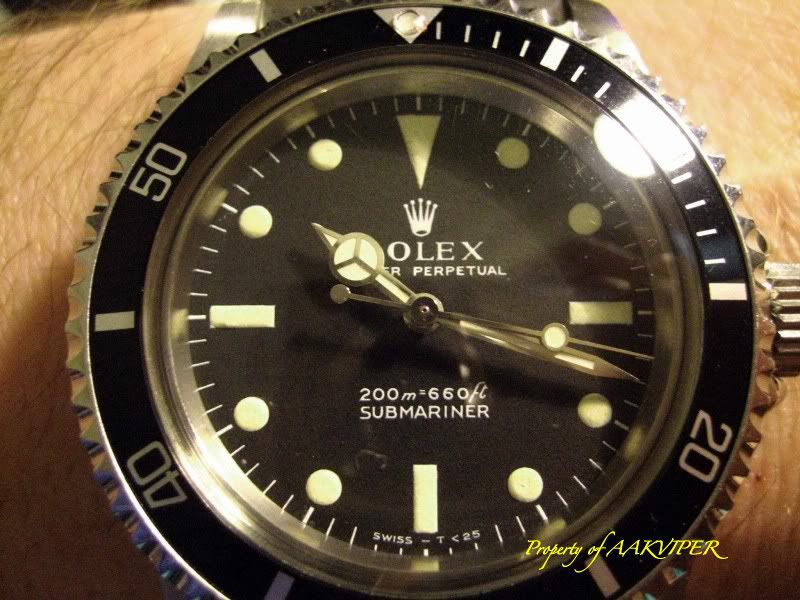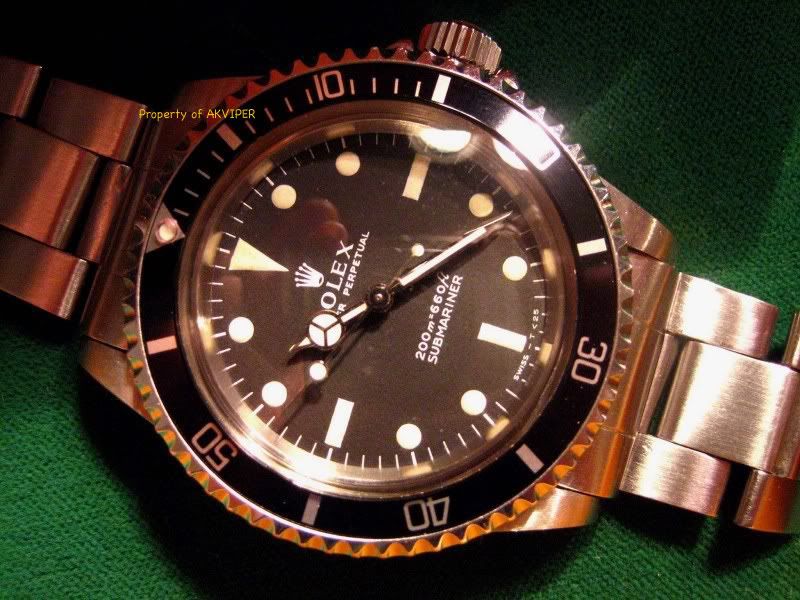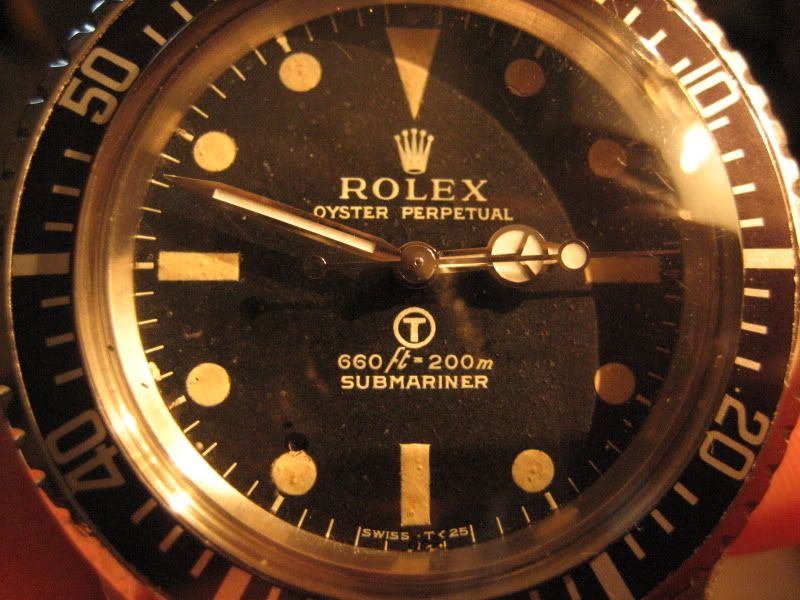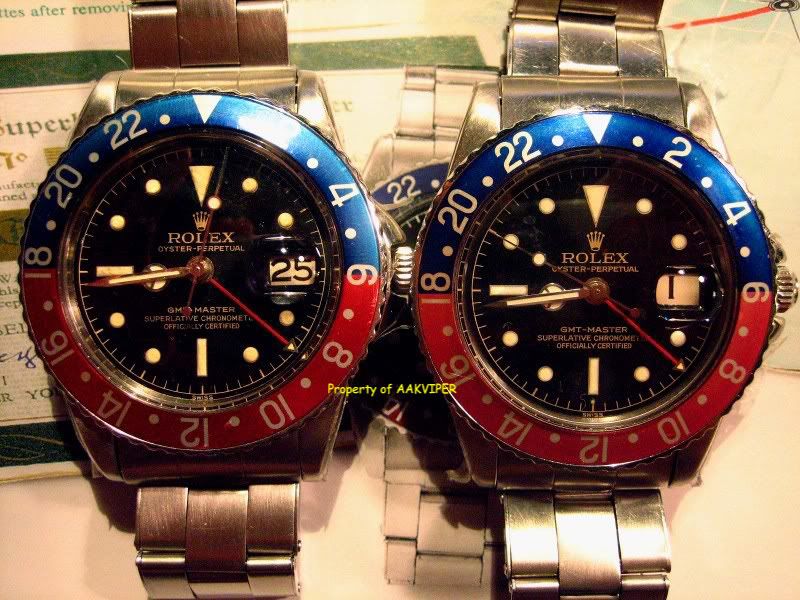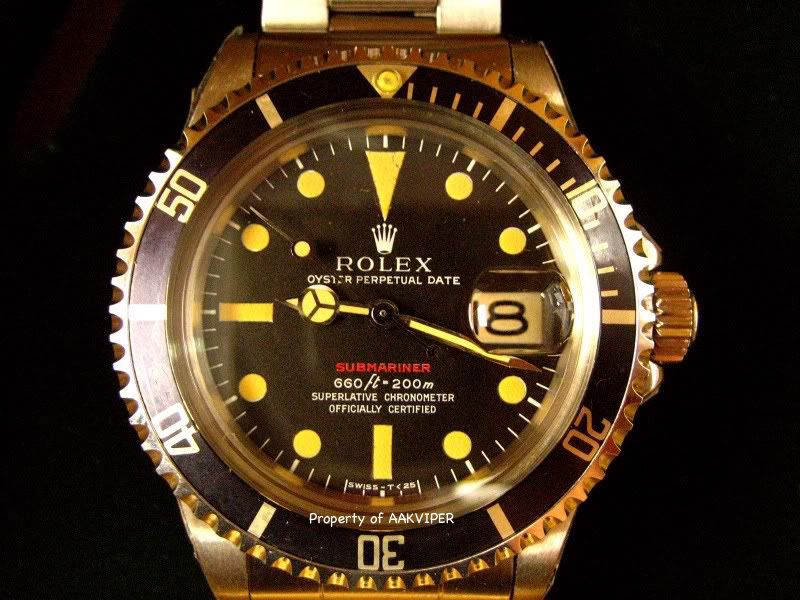Before we commence our review of te 5512 model.
I would like to point out the rare 5512 circa 1959 with the rare early 1st gen Swiss outer chapter ghost coronet silver and gold gilt font four line dialed early 1 generation watches. This early swiss type of dial does not have the usual flat coronet found on later 2 gen Swiss outer chapter ring dials. The seperation between the four lines, top two being of gold gilt, and the bottom two of silver gilt print is unique to this dial.
Below we have two early Subs one being an early 5508 with ghost face coronet dial and the other an eraly 5512 with the same type of dial. This type of coronet was so named because it resembles a ghost face.
The thicker case is based on the square guard first gen 5512 with non chronometer rated two line dial. A very rare transitional 5512 is and an important part of the Sub's evolution.
I just love the 5512, and wear everyone in my watch rotation. My favorites are the gold gilt gloss dialed editions.
Pointed or with the round crown guard, as long as it is a 5512 it gets my attention.
I love the look of the dial and the very accurate 1530, 1560, and 1570 calibers.
What I found to be very interesting to me was, that the 5512 was a truly small production model by Rolex.
I have always ascertained that the 5512 was a hard model to sell to customers. I say this because it looks almost exactly as the less expensive 5513 to the eyes of a new customer in that era. I bet it was hard to justify the extra cost from upgrading from a 5513 to the 5512 to the perspective client
The sales pitch must have been difficult to administer, two extra lines on the dial and a more precise caliber seems like a hard sell to me.
But apparently customers agreed with my assessment, and my belief was that the 5513 outsold the 5512 (unofficially) 5 to 1.
Be as it may, unpopular models are sought after by collectors. The 1019, 1655, and 1530 to name a few have a large following.
Some of my 5512 collection below.

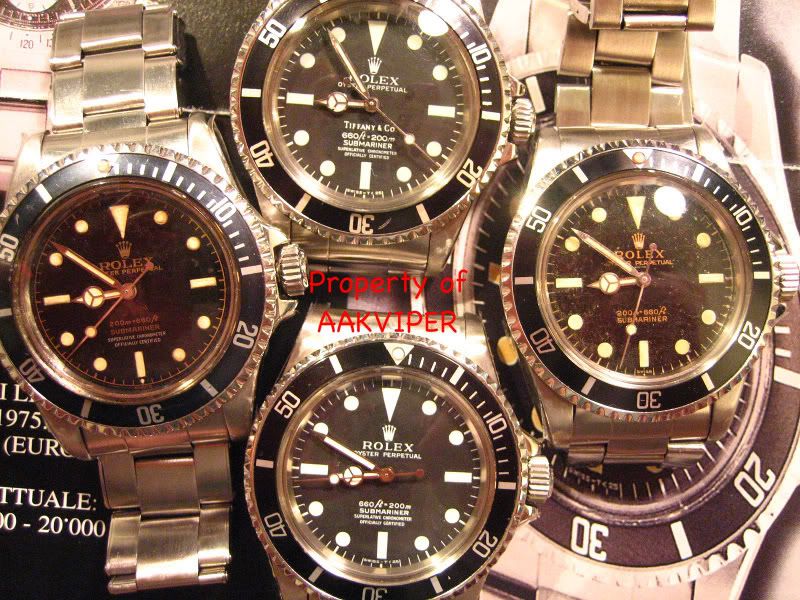
The pointed guard gloss "SWISS" four line gold and white print 5512 is in my opinion the must desirable 5512's to collect.


What I observed was that a similar gloss gold gilt print dial was also in the line up. The gloss gold print Swiss-T< 25 with gold and white dial print.
Believe it or not from what I have reserched on this dial, it is less commonly found then thought. It may be as rare as it's Gloss Swiss brother. I say this because I have seen far less numbers Swiss- T<25 1560="" 1963="" 1966="" 5512="" and="" as="" at="" auctions="" between="" both="" caliber.="" collectors.="" crown="" dealers="" dials.="" dials="" experances="" fall="" found="" from="" gloss="" guard="" in="" just="" my="" obervation="" of="" other="" ownership="" pointed="" production="" range="" research="" rolex="" rounded="" s.="" shows="" strong="" swiss-="" swiss="" t="" the="" these="" to="" vintage="" watch="" watches="" where="" with="" years="">The 5512 'Bart Simpson' coronet dialed Sub was produced between the years 1965 to maybe 1967.
Some collectors say the start date to be 1964. But maybe to early, at lest for me.
Small production run for only two to three years or so.
They can be found in pointed and round guard cases and on 5512-3 dials so far.
I have not seen any Bart coronet GMT or 1016 dials yet.
I believe they are more collectable because of the limited run. These Bart dials also have a tendency to turn brown with the right or should I say bad environment of humidly case leakage.
 Let us take a glance at the first pointed guard 5512 case.
Let us take a glance at the first pointed guard 5512 case.
 Besides the first 5512 square crown guard, I believe the second desirable case to collect would be the first generation 5512 pointed crown guard variant. From my research not all early 5512 crown guards have the same shape. The early release 1959 or so 5512's had a more define side angled peak to the crown guard shape. I noticed even back in the day on my early 5512 which I purchased ten years ago that this crown guard was not a run of the mill pointed guard. But back then when vintage Rolex was not mainstream yet, I did not have the research tools and other examples from other collectors or from dealers to put this puzzle together.
Besides the first 5512 square crown guard, I believe the second desirable case to collect would be the first generation 5512 pointed crown guard variant. From my research not all early 5512 crown guards have the same shape. The early release 1959 or so 5512's had a more define side angled peak to the crown guard shape. I noticed even back in the day on my early 5512 which I purchased ten years ago that this crown guard was not a run of the mill pointed guard. But back then when vintage Rolex was not mainstream yet, I did not have the research tools and other examples from other collectors or from dealers to put this puzzle together.
When one compares the second generation 5512 pointed crown guard case to the first generation, one can see in my opinion a lack of defined sharper side peak side area. It also appears to me that the second generation crown guard sticks out a little farther in covering the side crown field area. While the first generation crown guard comes at a steeper angle and sticks out less.
 The first generation pointed guard 5512 case with this unique crown guard shape seems to have been produced around the 5xxxxx range with possibly only III 59 case backs. As with very early 5512's, the reference and serial numbers were placed at the top of the middle case area unlike the latter bottom number case placement.
The first generation pointed guard 5512 case with this unique crown guard shape seems to have been produced around the 5xxxxx range with possibly only III 59 case backs. As with very early 5512's, the reference and serial numbers were placed at the top of the middle case area unlike the latter bottom number case placement.
 I have only seen a small amount of this 5512 crown guard variation over time by way of collectors and watch dealers. Unfortunately many of these early 5512's had bad case polishes and the definition was not as crisp as it once was.
Recently I noticed an expose about the early 5512 square and first generation crown guard in the 2009 Italian watch magazine named OM.
I have only seen a small amount of this 5512 crown guard variation over time by way of collectors and watch dealers. Unfortunately many of these early 5512's had bad case polishes and the definition was not as crisp as it once was.
Recently I noticed an expose about the early 5512 square and first generation crown guard in the 2009 Italian watch magazine named OM.
I conducted a comparison photo of my early 5512 to the 5512 picture displayed in the magazine article.
One conjecture that really caught my attention was that allegedly a few early square guard 5512 were filled down to a pointed configuration to make it easier for divers to set the crown. Could this explain the sharp angles of the first generation pointed guard?
 Be as it may, I found the early 5512 case crown guard research interesting and on going, while the OM magazine is NOT a Rolex factory resource verification tool. This article did add some new perspective of why maybe we have different 5512 case shapes over the years. OM is a pleasure reading magazine so take what is written in perspective, as many articles are just conjecture of people think and not 100% correct.
It appears that the early 5512 case design was truly unique..
Be as it may, I found the early 5512 case crown guard research interesting and on going, while the OM magazine is NOT a Rolex factory resource verification tool. This article did add some new perspective of why maybe we have different 5512 case shapes over the years. OM is a pleasure reading magazine so take what is written in perspective, as many articles are just conjecture of people think and not 100% correct.
It appears that the early 5512 case design was truly unique..
Istacked a 1963 5512 over my 1959 5512. Looks to me that the lug on the 1959 case (bottom one) is thicker then the 5512 1963 top case lug. Also notice the more prominent curve on the 1959 case lug. The 1963 has more of a slant to it.
See the photo blow..interesting perspective on case design evolution.








